September 19. RUHENGERI "Muzungus in the Mist" We left in plenty of time to get to the park headquarters on the morning of our gorilla visit. A small four door truck ushered us up to the park entrance. It was a beautiful drive and the weather was clear for the time being. As we passed people walking along the road we saw them hold out their hands. It looked like a begging gestures but just turned out to be the signal for hitching a ride. The road took us past some small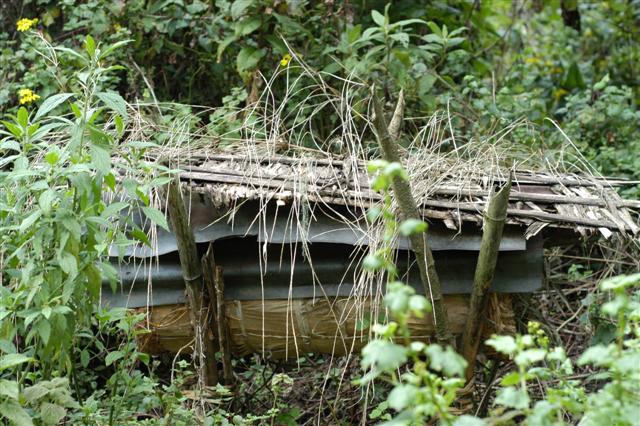 communities as we approached the awesome volcanic peaks that protruded into the sky. We had a glimpse of them the night before but they looked bigger than ever with the clear sky behind them. Unlike the solitary profile of Mt. Kilmanjaro these volcanoes were nestled together, making the small Virunga range in the corner of Rwanda's rolling green jungle-scape. It was King Kong country, like the old black and white movie. The geographical area crossed over into Uganda and the DRC but Rwanda offered the best gorilla viewing. The gorillas live in all three countries with the Congo having the most, Rwanda having the second largest population, and Uganda only having a family or two. communities as we approached the awesome volcanic peaks that protruded into the sky. We had a glimpse of them the night before but they looked bigger than ever with the clear sky behind them. Unlike the solitary profile of Mt. Kilmanjaro these volcanoes were nestled together, making the small Virunga range in the corner of Rwanda's rolling green jungle-scape. It was King Kong country, like the old black and white movie. The geographical area crossed over into Uganda and the DRC but Rwanda offered the best gorilla viewing. The gorillas live in all three countries with the Congo having the most, Rwanda having the second largest population, and Uganda only having a family or two.
It took just under an hour on a bumpy dirt road to reach the park headquarters and we were the first people to arrive. They had some hot water and cups out for fixing our own coffee or tea while we waited and the small gift shop was open. We put down our names and went to get a cup of coffee while we waited for other people to arrive. Once everyone was accounted for they divided us up into five groups. Each group was limited to eight people and would visit separate families of gorillas. As the dividing started I ran to use the toilet one last time. When I returned I was surprised to find Rob standing alone with two guides next to a sign for the Susa group, a big smile on his face. The other groups were larger and wanted to stay with their fellow travelers so nobody else was added to our group. We had our own tour! Rob had put in a request to visit the Susa group,  the largest gorilla family and the farthest away from the park headquarters. Their distance was a deterrent to some tourist and it probably meant we would walk much longer than in the other groups in search of our gorillas but it was exciting to have the tour to ourselves. The Susa family had 36 gorillas, including two silverbacks, and a four-month old set of twins. They were also home to one of Dian Fossey's famous gorillas, Poppy. I had just read "Gorillas in the Mist" and in the book Poppy was just a baby gorilla, now she is a matron in her thirties. Dian Fossey was the pioneer in mountain gorilla study, living in this jungle for almost 18 years. On December 26, 1985 she was found murdered in her Virunga cabin. To this day her death remains unsolved. Her life made her a controversial figure in Rwanda as she fought hard to preserve the existence of the mountain gorillas. She both challenged and befriended many people including poachers, local officials and the government in her quest. It is suspected that people know who killed her but it may never come to light. She is buried in the Volcano National Park. the largest gorilla family and the farthest away from the park headquarters. Their distance was a deterrent to some tourist and it probably meant we would walk much longer than in the other groups in search of our gorillas but it was exciting to have the tour to ourselves. The Susa family had 36 gorillas, including two silverbacks, and a four-month old set of twins. They were also home to one of Dian Fossey's famous gorillas, Poppy. I had just read "Gorillas in the Mist" and in the book Poppy was just a baby gorilla, now she is a matron in her thirties. Dian Fossey was the pioneer in mountain gorilla study, living in this jungle for almost 18 years. On December 26, 1985 she was found murdered in her Virunga cabin. To this day her death remains unsolved. Her life made her a controversial figure in Rwanda as she fought hard to preserve the existence of the mountain gorillas. She both challenged and befriended many people including poachers, local officials and the government in her quest. It is suspected that people know who killed her but it may never come to light. She is buried in the Volcano National Park.
From the park headquarters we now had to drive all of the way back through Ruhengeri and farther to reach the starting point for our hike. It took us over an hour and a half to reach the trail head. We passed through several villages along the way. It was a Sunday morning so we saw many people dressed in their best clothes, heading to church. Part of it was on the highway where the village had large clothes laid out along the road with sorghum drying in the morning sun. The last part of the drive we had to head off of the highway and up another steep bumpy road to where the dirt parking lot stood, below the Karisimbi Volcano. The first one turned out to be a false start when our guide learned that the gorillas were on the move. We drove a bit farther and parked again. There we left our truck and driver and set out on foot. We passed through a small community of homes and crops for about a half hour, slowly ascending until we reached the edge of a bamboo forest. We passed fields filled with pyrethrum, a little white-flowered plant used as a natural insecticide and one of Rwanda's important exports. There we met three armed military men who would accompany us going forward. They claimed the escort was for protection from the "buffalos" but there had also been problems with guerillas in the nearby DRC so that was the more likely reason..JPG)
At the edge of the forest we stopped and our head guide gave us an overview of what to expect and how to behave during our visit. We had to walk on a trail for the first part of the hike and then we would have to leave the trail and follow the gorilla tracks until we reached the group. Trackers stayed with the gorillas at all times of the day and were radioing our guide with updates on their whereabouts. As we entered the bamboo forest we were immediately engulfed in the shade provided by the tall wispy trees. Occasionally we encountered some local people coming out of the forest carrying water. The relationship between the people and the gorillas has had a tenuous history. For years poaching and deforestation were threatening the gorillas' survival. Rwanda is a densely packed country, is poor, and has undergone some very difficult times. It is easy to understand why the people tried to use whatever means necessary to sustain themselves, including selling gorilla parts, eating bush meat (gorilla meat), and deforesting the land for food cultivation. Today they seem to have reached a sort of balance. Tourism is bringing money into the economy and part of the fat fee we pay to visit the gorillas goes to supporting the surrounding communities, giving them an interest in the tourism success. They also have privileges that allow them to come into the park for water resources. Some also tried to sneak into the park to set up bee farms but that was officially against the rules. Our guides pointed out one that had been destroyed but we saw another that had been newly built. They needed to be built above the bamboo line so it took the local people too close to the gorilla habitat.
The trail was slippery and, at times, quite steep but very scenic. The tough bamboo shoots made for helpful handholds as we scrambled up the steeper portions but also smacked and poked us along the way. We were frequently scratched by nettles and left with a persistent itch wherever they broke the skin. At 2600 meters the bamboo forest gave gradually gave way to the Hagenia and Hypericum vegetation zone. The bamboo trees got shorter and shorter as we ascended until we were finally walking in the more open vegetation. It was turning out to be a fairly rigorous hike but we still had a ways to go to find our gorillas. At this point we veered off of the more well traveled trail and picked up the actual gorilla trail. 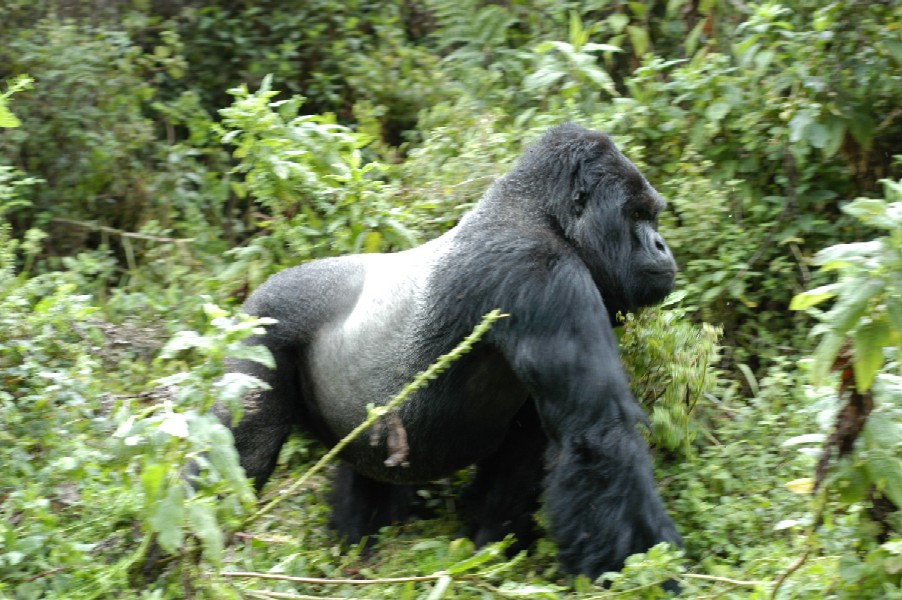 Gorillas are constantly on the move throughout their day, eating and moving, eating and moving, napping, then more eating and moving until they make a final nest for the night. This meant that our hiking leveled off a bit, then went down, then up, then down, then around as we tried to find the best route past a ravine. At times the vegetation opened up and we could get views of the landscape below. Gorillas are constantly on the move throughout their day, eating and moving, eating and moving, napping, then more eating and moving until they make a final nest for the night. This meant that our hiking leveled off a bit, then went down, then up, then down, then around as we tried to find the best route past a ravine. At times the vegetation opened up and we could get views of the landscape below.
Our head guide stopped from time to time to show us the gorilla signs. They way the vegetation was broken was a giveaway. Movement of 36 gorillas left an unmistakable path. Unlike the flat stomped out trails made by humans the plants were more casually pushed aside and smashed down to allow the gorillas to just roll over them using both feet and knuckles. We tried a taste of the wild celery that was a favorite of the gorillas. It tasted much like our domestic variety but with a bit more fiber. Our guide also pointed out areas that had been flatted out for napping.
We made a couple of false turns as the guides tried to connect with the trackers. Even the military escorts were pitching in to get us to the right place. My legs were getting pretty tired towards the end. We had been hiking steadily for about two and half hours before I finally heard some faint crunching. There was nothing in sight so I figured we still had farther to go but as we came up onto a knoll I saw there were three men standing ahead of us with rain gear, our trackers. My eyes focused on them but then I noticed many fuzzy black heads bobbing in the field behind them. The group had separated for feeding but this was the biggest of the two. There must have been twenty gorillas out there. The rule was that we didn't get any closer than 15 feet so I thought we had reached our final lookout point but our guides told us to leave our packs an follow them. Our packs had our lunches in them and the park was careful that no human food get in the hands of the gorillas. They were susceptible to similar diseases as humans and food could transmit germs. That was the main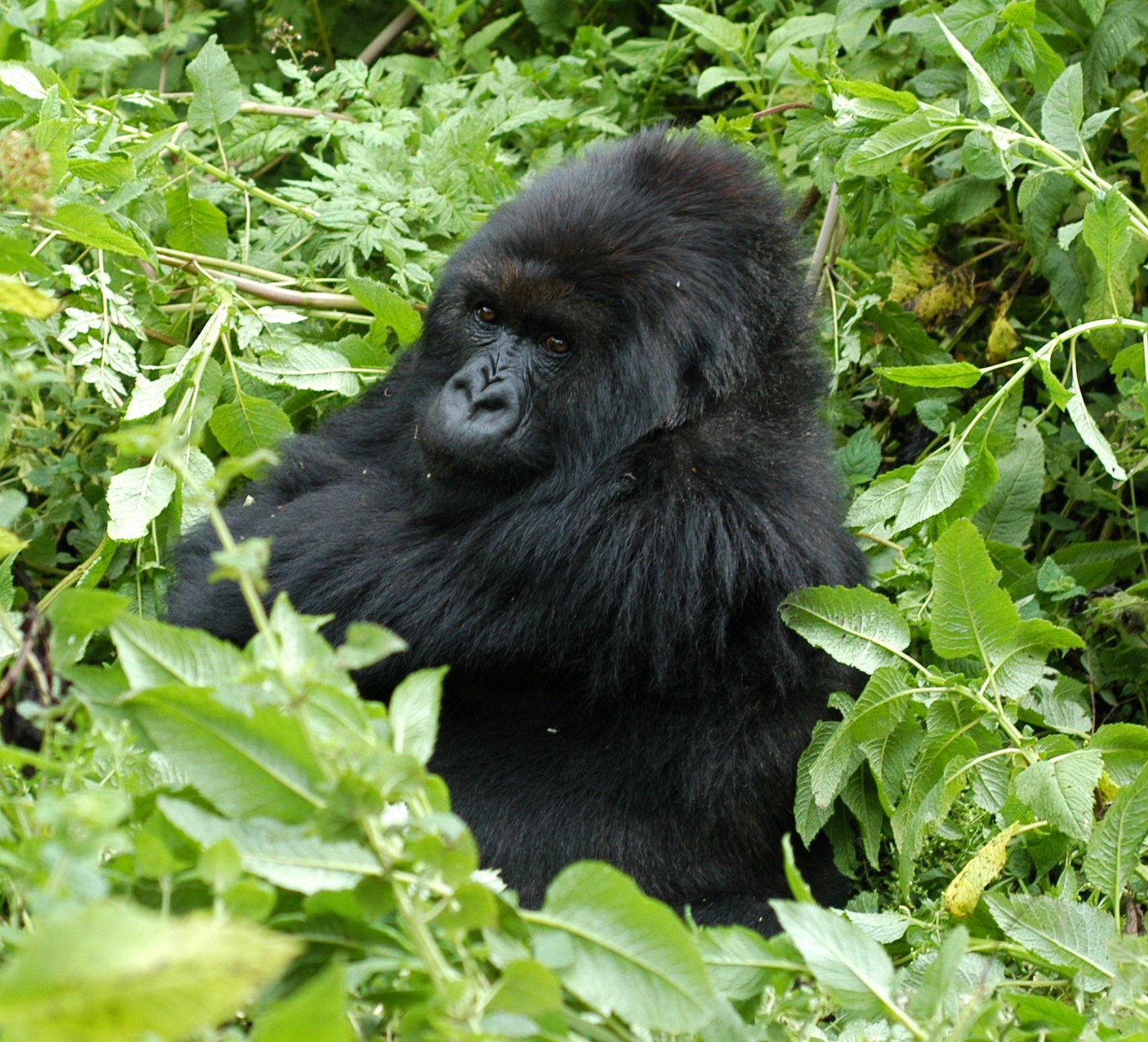 reason for keeping us far away from the animals. A person with even a cold was not allowed to make a visit to the gorillas. reason for keeping us far away from the animals. A person with even a cold was not allowed to make a visit to the gorillas.
Our guides slowly lead us down a small hill to where the field opened up. One guide was ahead of us and the other behind. We moved slowly and carefully but hadn't gotten very far when were told to stop. Just to the side was a female gorilla with her back to us. When we stopped she turned to look at us and tiny little head popped up in her arms and peered as us wide-eyed over her shoulder. This was the mother of the twins. We could just see the one and he was quite intent on checking us out. We were a curious sight. He pushed his little arms against his mother to leverage himself up for a better look. Mom thought better of it and decided to move her kids farther up the hill, crossing the trail and heading into thicker brush. Just then large silverback emerged from the tall grass and swept across our path. He moved casually but deliberately, not even giving us a second look. he wasn't the head silverback but was an impressively big animal. The famous Poppy also sat nearby but gave us a bored look and rolled away with a smaller gorilla at her side.
We followed our guides through the gorilla field, trying to maintain our distance as the animals surrounded us on all sides. Occasionally one would catch us off guard and just cruise right past us on their way to a new munching ground. We stood back as far as space allowed and gave them a clear path. The mother and her twins made a brazen sweep past us, the babies clinging to their mother's chest, her right arm wrapped around them while she used the other to walk. They didn't seem much interested in us except for the younger ones. The older gorillas had seen people many times before so we held little interest for them. There was a time, when poaching was a more serious problem, that people were seen as a serious threat and would have been scared off by the males in the group. But today they are pretty habituated to human visits and know the regular trackers and guides well. Our guides said that they even could differentiate between people of different races. 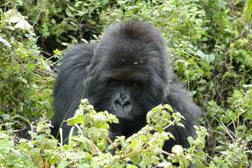 The lead guide frequently made grunting noises to assure the gorillas that we came as friends. The lead guide frequently made grunting noises to assure the gorillas that we came as friends.
We came upon Poppy again, this time sitting on her own, so we paused to watch her for a moment. She was a bold old gal with grey just starting to emerge around her neck. She eyed us with a kind of condescending look and crossed her arms. It appeared that she wasn't in the mood to meet people today. Our guides took us further up the slope and stopped us abruptly when the head silverback came into view. He was clearly bigger than the one we had seen earlier. The full-sized silverbacks can reach over 200kg but it was hard to image how they grew so big on a vegetarian diet. His massive back was to us but he turned to give us a look. Our guide let out another guttural noise to let him know that we came as friends. He mildly grunted and then hoisted himself up, waived his bum in our faces, and head over the edge of the hill.
At this point there were gorillas around us on all sides, munching away on one thing or another, tucked away under trees and obscured behind walls of tall grass. Perhaps that was why they took us in just a group of two people. We had to stay close together to keep our distance from the gorillas but with so many of them it was hard to do. If we had been a group of eight it would have been impossible. Our guides also told us that the group had recently suffered a death and were in mourning so the park wanted to slowly ease them back into the viewing schedule. There were more families in the park than there were visiting groups on any one day so none of the gorillas groups had to put up with being viewed every single day.
 After the big daddy left a younger gorilla (a toddler) approached from above, pausing on a small outcrop of grass. He was curious about us and keen to get some attention. He proceeded to demonstrate his agility with some twirling action and leaping around until he almost made us dizzy. A smaller baby gorilla was sitting close to its mother, both nibbling away on food, but the baby kept craning its little neck around to give us a look. Just then another mother and baby came walking past us. This time the baby was clinging to its mother's back and caught sight of us as they went by, her little eyes opening with amusement. After the big daddy left a younger gorilla (a toddler) approached from above, pausing on a small outcrop of grass. He was curious about us and keen to get some attention. He proceeded to demonstrate his agility with some twirling action and leaping around until he almost made us dizzy. A smaller baby gorilla was sitting close to its mother, both nibbling away on food, but the baby kept craning its little neck around to give us a look. Just then another mother and baby came walking past us. This time the baby was clinging to its mother's back and caught sight of us as they went by, her little eyes opening with amusement.
At the top of the hill there was a cluster of trees and several of the gorillas were snuggled into nests, watching the rest of the group from on high. One peeked out at us right over the lower branches but feigned a lack of interest. Another leaned backwards from the overhang branches to give us a look, glanced past us, then eyed us again and lifted her chin to give herself a scratch. None of them seemed bothered by us but in the brief moments of each encounter we could detect the individual personalities. Poppy was an older female with attitude. The silverback was quite full of himself. The young gorillas were curious or coy. Then there were some that looked mildly interested in us but didn't want to look interested. They were old enough that people weren't a new thing but they still found us a little bit amusing. We had to try hard to refrain from pointing, a gesture that gorillas can 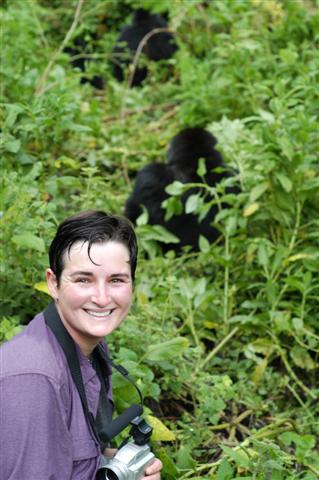 misinterpret as aggressive. There were just so many little things that they did that demonstrated their intelligence and gentleness; the ways in which they interacted with each other and responded to us. misinterpret as aggressive. There were just so many little things that they did that demonstrated their intelligence and gentleness; the ways in which they interacted with each other and responded to us.
After about a half hour of gorilla viewing it began to rain and then rain hard. The gorillas scattered to find cover. They didn't like to get wet either. We squeezed under a nearby tree to wait out the showers. It wasn't until we had been there for a few minutes that we realized we weren't alone. About ten feet away, almost totally hidden in the brush, was a middle-aged gorilla. He continued to eat but eyed us through the branches. We stayed still so as not to bother him or drive him from his shelter. Once the rain had let up a bit we moved back up the hill to the highest cluster of trees. There was an opening between them so we climbed a bit farther and found more gorillas tucked away under the trees. We sat quietly for a moment and just observed. One male, an older one but not yet turning gray, looked totally bored with his predicament. He returned our looks with what looked like a sigh, his left fist shoved under his chin. This rain put a real damper in the feeding schedule.
When our hour was up it was hard to pull ourselves away from the gorillas. They were such amazing animals, such intelligent characters. It was impossible not to adore them. There was no question that the money and effort had been more than worth it. The trackers stayed on with the gorillas so Rob gave them a tip for their work before we headed back down the mountain. It was much quicker and more direct going back down. We had come farther south and were able to take a different trail back to the truck. Once we reached the bamboo canopy again we stopped to eat lunch but even with that we were down in less than 45 minutes. The trail was wet from the rain and there was some slipping and sliding but I was too elated from our experience to mind. At the bottom we traversed along the edge of the bamboo forest to reach our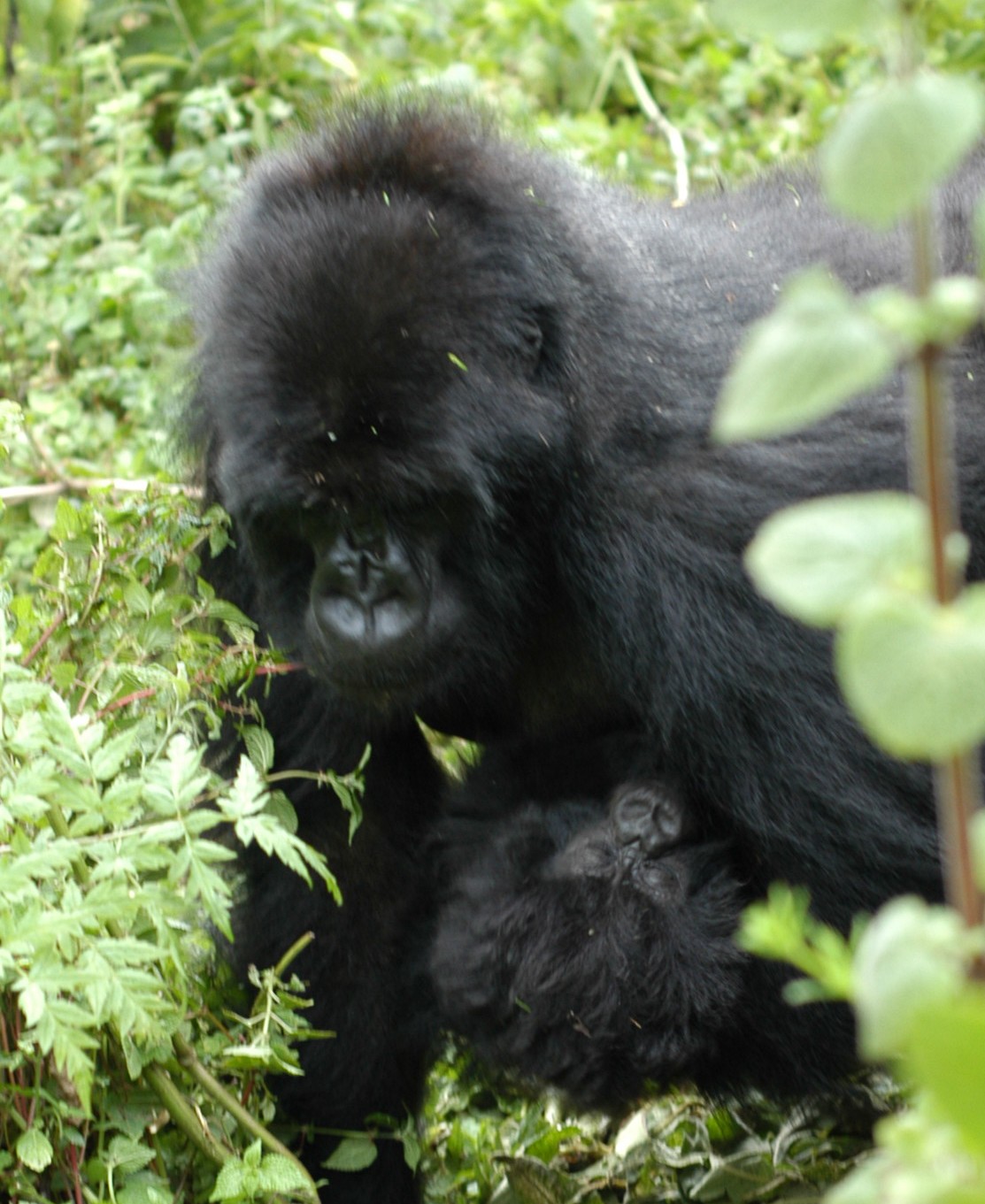 original trail and then went back through the village. A few children yelled "Agachupa!" at us, which meant plastic bottle but our guides had advised against giving them any bottles. Apparently it caused problems with children being kept out of school to beg. original trail and then went back through the village. A few children yelled "Agachupa!" at us, which meant plastic bottle but our guides had advised against giving them any bottles. Apparently it caused problems with children being kept out of school to beg.
Before we got back in our truck we made sure to get some photos of the guides and our military escorts. All in all it had been a team of eight men who had made our visit to the gorillas possible - two guides, three military escorts, and three trackers - and all had played their part in making it a successful visit. The military escorts looked surprised to get a bit of a tip but we felt they deserved it. None of them proactively asked for anything. Our guides had done an excellent job and definitely earned something extra. When I asked our lead guide how he liked his work he said it was a great job. He had been doing it for eight years.
The truck let us off at our hotel. We were both tired and badly in need of getting cleaned up. We'd only been guaranteed the one night at the hotel so we left our bags in the hotel office during the gorilla visit. We were dreading having to go out and search for another place to stay but our luck held out. When we went to the office to retrieve our bags they told that a room had opened up. In fact they let us return to the room we'd had the night before. After getting cleaned up we enjoyed a nice hearty dinner at the hotel restaurant but we had to walk there in the dark. Right at sunset, as everyone cranked on their lights and started cooking for dinner, out went the electricity! |

